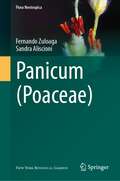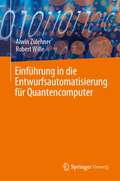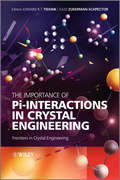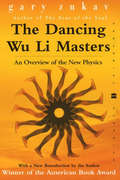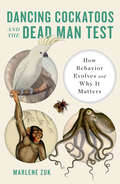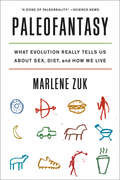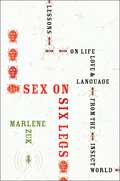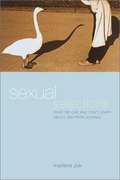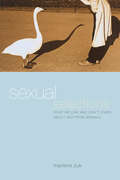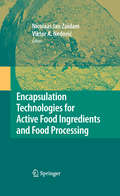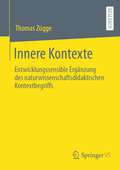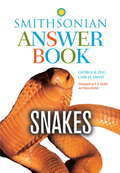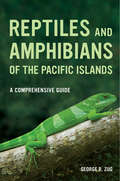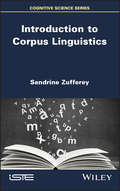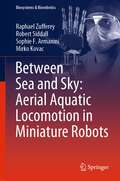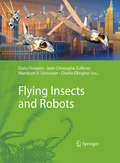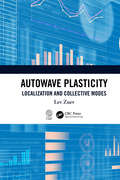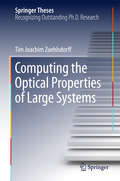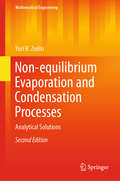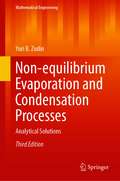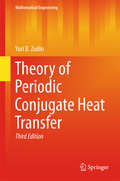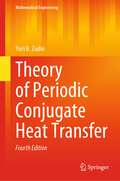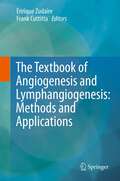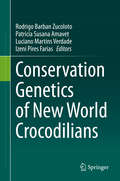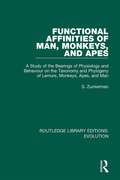- Table View
- List View
Panicum (Flora Neotropica #124)
by Fernando Zuloaga Sandra AliscioniThis work will be volume 124 in the Flora Neotropica Monograph book Series, Lawrence M. Kelly (Editor-in-Chief). Flora Neotropica volumes provide taxonomic treatments of plant groups or families growing in the Americas between the Tropic of Cancer and the Tropic of Capricorn. This monograph on Panicum (Poaceae), known as panicgrass, was written by the world-leading authority on this plant group. A total of one genus and 63 species are described. It also includes information on conservation, phylogenetic relationships, taxonomic history, ecology, cytology, and anatomy, among other topics. This is the first comprehensive volume on this topic since the 1920s and is lavishly illustrated with line drawings, black and white photographs, and distribution maps.
Einführung in die Entwurfsautomatisierung für Quantencomputer
by Alwin Zulehner Robert WilleDieses Buch bietet dem Leser einen einfachen Einstieg in das Quantencomputing sowie in den Entwurf entsprechender Geräte. Die Autoren behandeln verschiedene Entwurfsaufgaben, die für das Quantencomputing wichtig sind, und stellen entsprechende Lösungen vor. Eine Besonderheit des Buches ist, dass diese Aufgaben und Lösungen explizit aus der Perspektive der Entwurfsautomatisierung diskutiert werden, d.h. unter Verwendung von cleveren Algorithmen und Datenstrukturen, die von der Entwurfsautomatisierungs-Community für konventionelle Logik (d.h. für elektronische Geräte und Systeme) entwickelt worden sind und nun für diese neue Technologie angewendet werden. Auf diese Weise können relevante Entwurfsaufgaben wesentlich effizienter als bisher durchgeführt werden, was zu Verbesserungen um mehrere Größenordnungen führt (in Bezug auf die Laufzeit und andere Entwurfsziele). Beschreibt den aktuellen Stand der Technik für den Entwurf von Quantenschaltungen, für deren Simulation und für deren Abbildung auf reale Hardware; Bietet eine erste umfassende Einführung in die Entwurfsautomatisierung für Quantencomputer, die sich mit praxisrelevanten Aufgabenstellungen befasst; Es richtet sich sowohl an die Quantencomputer-Gemeinschaft als auch an die Gemeinschaft der Entwurfsautomatisierung und zeigt, welche beeindruckenden Verbesserungen möglich sind, wenn man das Wissen beider Gemeinschaften kombiniert.
The Importance of Pi-Interactions in Crystal Engineering
by Julio Zukerman-Schpector Edward R. TiekinkCrystal engineers aim to control the way molecules aggregate in the crystalline phase and are therefore concerned with crystal structure prediction, polymorphism, and discovering the relative importance of different types of intermolecular forces and their influence on molecular structure. In order to design crystal structures, knowledge of the types, strengths, and nature of possible intermolecular interactions is essential. Non-covalent interactions involving p-systems is a theme that is under extensive investigation as these interactions can be inductors for the assembly of a vast array of supramolecular architectures.The Importance of Pi-Interactions in Crystal Engineeringcovers topics ranging from the identification of interactions involving p-systems, their impact on molecular and crystal structure in both organic and metallorganic systems, and how these interactions might be exploited in the design of new materials. Specialist reviews are written by internationally recognized researchers drawn from both academia and industry.The Importance of Pi-Interactions in Crystal Engineeringprovides an essential overview of this important aspect of crystal engineering for both entrants to the field as well as established practitioners, and for those working in crystallography, medicinal and pharmaceutical sciences, solid-state chemistry, physical chemistry, materials and nanotechnology
The Dancing Wu Li Masters
by Gary ZukavWith its unique combination of depth, clarity, and humor that has enchanted millions, this beloved classic by bestselling author Gary Zukav opens the fascinating world of quantum physics to readers with no mathematical or technical background. "Wu Li" is the Chinese phrase for physics. It means "patterns of organic energy," but it also means "nonsense," "my way," "I clutch my ideas," and "enlightenment." These captivating ideas frame Zukav's evocative exploration of quantum mechanics and relativity theory. Delightfully easy to read, The Dancing Wu Li Masters illuminates the compelling powers at the core of all we know.
Dancing Cockatoos and the Dead Man Test: How Behavior Evolves And Why It Matters
by Marlene ZukA lively exploration of animal behavior in all its glorious complexity, whether in tiny wasps, lumbering elephants, or ourselves. For centuries, people have been returning to the same tired nature-versus-nurture debate, trying to determine what we learn and what we inherit. In Dancing Cockatoos and the Dead Man Test, biologist Marlene Zuk goes beyond the binary and instead focuses on interaction, or the way that genes and environment work together. Driving her investigation is a simple but essential question: How does behavior evolve? Drawing from a wealth of research, including her own on insects, Zuk answers this question by turning to a wide range of animals and animal behavior. There are stories of cockatoos that dance to rock music, ants that heal their injured companions, dogs that exhibit signs of obsessive-compulsive disorder, and so much more. For insights into animal intelligence, mating behavior, and an organism’s ability to fight disease, she explores the behavior of smart spiders, silent crickets, and crafty crows. In each example, she clearly demonstrates how these traits were produced by the complex and diverse interactions of genes and the environment and urges us to consider how that same process evolves behavior in us humans. Filled with delightful anecdotes and fresh insights, Dancing Cockatoos and the Dead Man Test helps us see both other animals and ourselves more clearly, demonstrating that animal behavior can be remarkably similar to human behavior, and wonderfully complicated in its own right.
Paleofantasy: What Evolution Really Tells Us about Sex, Diet, and How We Live
by Marlene Zuk"With . . . evidence from recent genetic and anthropological research, [Zuk] offers a dose of paleoreality."--Erin Wayman, Science News We evolved to eat berries rather than bagels, to live in mud huts rather than condos, to sprint barefoot rather than play football--or did we? Are our bodies and brains truly at odds with modern life? Although it may seem as though we have barely had time to shed our hunter-gatherer legacy, biologist Marlene Zuk reveals that the story is not so simple. Popular theories about how our ancestors lived--and why we should emulate them--are often based on speculation, not scientific evidence. Armed with a razor-sharp wit and brilliant, eye-opening research, Zuk takes us to the cutting edge of biology to show that evolution can work much faster than was previously realized, meaning that we are not biologically the same as our caveman ancestors. Contrary to what the glossy magazines would have us believe, we do not enjoy potato chips because they crunch just like the insects our forebears snacked on. And women don't go into shoe-shopping frenzies because their prehistoric foremothers gathered resources for their clans. As Zuk compellingly argues, such beliefs incorrectly assume that we're stuck--finished evolving--and have been for tens of thousands of years. She draws on fascinating evidence that examines everything from adults' ability to drink milk to the texture of our ear wax to show that we've actually never stopped evolving. Our nostalgic visions of an ideal evolutionary past in which we ate, lived, and reproduced as we were "meant to" fail to recognize that we were never perfectly suited to our environment. Evolution is about change, and every organism is full of trade-offs. From debunking the caveman diet to unraveling gender stereotypes, Zuk delivers an engrossing analysis of widespread paleofantasies and the scientific evidence that undermines them, all the while broadening our understanding of our origins and what they can really tell us about our present and our future.
Sex on Six Legs: Lessons on Life, Love, and Language from the Insect World
by Marlene ZukInsects have inspired fear, fascination, and enlightenment for centuries. They are capable of incredibly complex behavior, even with brains often the size of a poppy seed. How do they accomplish feats that look like human activity-- personality, language, childcare--with completely different pathways from our own? What is going on inside the mind of those ants that march like boot-camp graduates across your kitchen floor? How does the lead ant know exactly where to take her colony, to that one bread crumb that your nightly sweep missed? Can insects be taught new skills as easily as your new puppy? Sex on Six Legs is a startling and exciting book that provides answers to these questions and many more. With the humor of Olivia Judson's Dr. Tatiana's Sex Advice to All Creation, Zuk not only examines the bedroom lives of creepy crawlies but also calls into question some of our own longheld assumptions about learning, the nature of personality, and what our own large brains might be for.
Sexual Selections: What We Can and Can't Learn about Sex from Animals
by Marlene ZukZuk takes the reader on a tour, and her message is an eloquent and important warning: because gender biases have shaped the way researchers have studied animal behavior, and because we also look to the behavior of animals to inform ourselves about our own behavior, we are in danger of perpetuating these gender biases.
Sexual Selections: What We Can and Can't Learn about Sex from Animals
by Marlene ZukScientific discoveries about the animal kingdom fuel ideological battles on many fronts, especially battles about sex and gender. We now know that male marmosets help take care of their offspring. Is this heartening news for today's stay-at-home dads? Recent studies show that many female birds once thought to be monogamous actually have chicks that are fathered outside the primary breeding pair. Does this information spell doom for traditional marriages? And bonobo apes take part in female-female sexual encounters. Does this mean that human homosexuality is natural? This highly provocative book clearly shows that these are the wrong kinds of questions to ask about animal behavior. Marlene Zuk, a respected biologist and a feminist, gives an eye-opening tour of some of the latest developments in our knowledge of animal sexuality and evolutionary biology. Sexual Selections exposes the anthropomorphism and gender politics that have colored our understanding of the natural world and shows how feminism can help move us away from our ideological biases. As she tells many amazing stories about animal behavior--whether of birds and apes or of rats and cockroaches--Zuk takes us to the places where our ideas about nature, gender, and culture collide. Writing in an engaging, conversational style, she discusses such politically charged topics as motherhood, the genetic basis for adultery, the female orgasm, menstruation, and homosexuality. She shows how feminism can give us the tools to examine sensitive issues such as these and to enhance our understanding of the natural world if we avoid using research to champion a feminist agenda and avoid using animals as ideological weapons. Zuk passionately asks us to learn to see the animal world on its own terms, with its splendid array of diversity and variation. This knowledge will give us a better understanding of animals and can ultimately change our assumptions about what is natural, normal, and even possible.
Encapsulation Technologies for Active Food Ingredients and Food Processing
by N. J. Zuidam Viktor NedovicConsumers prefer food products that are tasty, healthy, and convenient. Encapsulation is an important way to meet these demands by delivering food ingredients at the right time and right place. For example, encapsulates may allow flavor retention, mask bad tasting or bad smelling components, stabilize food ingredients, and increase their bioavailability. Encapsulation may also be used to immobilize cells or enzymes in the production of food materials or products, such as fermentation or metabolite production. This book provides a detailed overview of the encapsulation technologies available for use in food products, food processing, and food production. The book aims to inform those who work in academia or R&D about both the delivery of food compounds via encapsulation and food processing using immobilized cells or enzymes. The structure of the book is according to the use of encapsulates for a specific application. Emphasis is placed on strategy, since encapsulation technologies may change. Most chapters include application possibilities of the encapsulation technologies in specific food products or processes. The first part of the book reviews general technologies, food-grade materials, and characterization methods for encapsulates. The second part discusses encapsulates of active ingredients (e.g., aroma, fish oil, minerals, vitamins, peptides, proteins, probiotics) for specific food applications. The last part describes immobilization technologies of cells and enzymes for use within food fermentation processes (e.g., beer, wine, dairy, meat), and food production (e.g., sugar conversion, production of organic acids or amino acids, hydrolysis of triglycerides). Edited by two leading experts in the field, Encapsulation Technologies for Food Active Ingredients and Food Processing will be a valuable reference source for those working in the academia or food industry. The editors work in both industry or academia, and they have brought together in this book contributions from both fields.
Innere Kontexte: Entwicklungssensible Ergänzung des naturwissenschaftsdidaktischen Kontextbegriffs
by Thomas ZüggeDer Kontextbegriff ist in der Naturwissenschaftsdidaktik wohletabliert. Das verleitet zu der Fehlannahme, er sei auch wohldefiniert. In dieser Arbeit wird gezeigt, dass die sehr un- terschiedlichen Verständnisse auch zu unterschiedlichen Zielsetzungen didaktischer Kon- textualisierung im naturwissenschaftlichen Unterricht führen. Die damit verbundenen Deutungen und Funktionen des Begriffs werden in einer Definition zusammengefasst. Dabei wird deutlich, dass die Entwicklung Heranwachsender bisher nicht Teil dessen ist, was didaktisch als Kontext des Unterrichts bezeichnet wird. Die im weiteren Verlauf eingeführte „entwicklungssensible Kontextualisierung“ versteht sich in bewusster Abgrenzung zu anderen diskutierten Ansätzen, die Entwicklungsprozesse Jugendlicher in der Unterrichtsgestaltung abzubilden. Ihre Grundlage sind „innere Kontexte“, deren Charakter aus einer umfangreichen Diskussion des Entwicklungsaufgabenbegriffs in der modernen Entwicklungspsychologie abgeleitet wird.
Snakes in Question, Second Edition
by George R. Zug Carl H. Ernst Richard D. Bartlett Patricia BartlettThis new edition of Snakes in Question has been completely updated to take into account the most recent research available, offering useful scientific information about snakes while dispelling many widely-circulated myths and common fears. Accompanied by 100 stunning color photographs and written in the popular question-and-answer format of Smithsonian's "In Question" series, the book tells how snakes breathe, hear, smell, and much more. It covers not only the life cycle of snakes but also explores such phenomena as the rattlesnake's rattle, the viper's hiss, and the snake charmer's secrets. It addresses common folktales about snakes (do snakes milk cows?) and describes giant snakes, both real and imaginary. The authors also give expert advice on such subjects as distinguishing venomous species from harmless look-alikes and keeping snakes as pets.
Reptiles and Amphibians of the Pacific Islands
by George R. ZugThe Pacific is not only the world's largest body of water; its vast expanse also includes an extraordinary number and diversity of oceanic islands, from Palau and the Marianas east of the Philippines to Cocos Island and the Galápagos west of the Americas. The isolation of these islands and the extreme distances between them long prevented scientists from studying their floras and faunas in a comparative context. But now George R. Zug, one of the world's foremost experts on the diverse reptiles and amphibians of the Pacific Basin, offers the first such systematic overview in more than half a century. Reptiles and Amphibians of the Pacific Islands is a compendium of frogs, lizards, snakes, and turtles living on these lands and in the adjacent waters of the oceanic islands in the tropical Pacific. The means to identify each species is included, along with entries that describe each animal's form, coloration, habitat, distribution, reproductive biology, and natural history. Color plates of more than 75 percent of the species also help to facilitate visual identification. This accessible and informative guide is the most comprehensive field guide available and will appeal to both novice sightseers and professional naturalists.
Introduction to Corpus Linguistics
by Sandrine ZuffereyOver the past decades, the use of quantitative methods has become almost generalized in all domains of linguistics. However, using these methods requires a thorough understanding of the principles underlying them. Introduction to quantitative methods in linguistics aims at providing students with an up-to-date and accessible guide to both corpus linguistics and experimental linguistics. The objectives are to help students developing critical thinking about the way these methods are used in the literature and helping them to devise their own research projects using quantitative data analysis.
Between Sea and Sky: Aerial Aquatic Locomotion in Miniature Robots (Biosystems & Biorobotics #29)
by Raphael Zufferey Robert Siddall Sophie F. Armanini Mirko KovacThis book reports on the state of the art in the field of aerial-aquatic locomotion, focusing on the main challenges concerning the translation of this important ability from nature to synthetic systems, and describing innovative engineering solutions that have been applied in practice by the authors at the Aerial Robotics Lab of Imperial College London. After a general introduction to aerial-aquatic locomotion in nature, and a summary of the most important engineering achievements, the book introduces readers to important physical and mathematical aspects of the multimodal locomotion problem. Besides the basic physics involved in aerial-aquatic locomotion, the role of different phenomena happening in fluids, or those due to structural mechanics effects or to power provision, are presented in depth, across a large dimension range, from millimeters to hundreds of meters. In turn, a practice-oriented discussion on the obstacles and opportunities of miniaturization, for both robots and animals is carried out. This is followed by applied engineering considerations, which describe relevant hardware considerations involved in propulsion, control, communication and fabrication. Different case studies are analyzed in detail, reporting on the latest research carried out by the authors, and covering topics such as propulsive aquatic escape, the challenging mechanics of water impact, and a hybrid sailing and flying aircraft. Offering extensive and timely information on the design, construction and operation of small-scale robots, and on multimodal locomotion, this book provides researchers, students and professionals with a comprehensive and timely reference guide to the topic of aerial-aquatic locomotion, and the relevant bioinspired approaches. It is also expected to inspire future research and foster a stronger multidisciplinary discussion in the field.
Flying Insects and Robots
by Jean-Christophe Zufferey Mandyam V. Srinivasan Dario Floreano Charlie EllingtonFlying insects are intelligent micromachines capable of exquisite maneuvers in unpredictable environments. Understanding these systems advances our knowledge of flight control, sensor suites, and unsteady aerodynamics, which is of crucial interest to engineers developing intelligent flying robots or micro air vehicles (MAVs). The insights we gain when synthesizing bioinspired systems can in turn benefit the fields of neurophysiology, ethology and zoology by providing real-life tests of the proposed models. This book was written by biologists and engineers leading the research in this crossdisciplinary field. It examines all aspects of the mechanics, technology and intelligence of insects and insectoids. After introductory-level overviews of flight control in insects, dedicated chapters focus on the development of autonomous flying systems using biological principles to sense their surroundings and autonomously navigate. A significant part of the book is dedicated to the mechanics and control of flapping wings both in insects and artificial systems. Finally hybrid locomotion, energy harvesting and manufacturing of small flying robots are covered. A particular feature of the book is the depth on realization topics such as control engineering, electronics, mechanics, optics, robotics and manufacturing. This book will be of interest to academic and industrial researchers engaged with theory and engineering in the domains of aerial robotics, artificial intelligence, and entomology.
Autowave Plasticity: Localization and Collective Modes
by Lev ZuevAutowave Plasticity: Localization and Collective Modes discusses the nature of plastic flow in solids associated with the development of a localized plastic flow. Written by an authority in the field, the author demonstrates how patterns of localized plastic flow are associated with autowave modes that are generated in a deformable sample and delivers a complete work on the subject. Key Features An original work on the nature of plastic flows in solids, particularly metals and crystals Focuses on plastic flow as an autowave process Contains elements of theories, experimental considerations, and numerical modeling This reference will help readers with creating experimental methods to observe or localize plastic flow and with the modeling of plastic flows. It is a valuable reference for graduate students and research specialists working in material science.
Computing the Optical Properties of Large Systems (Springer Theses)
by Tim Joachim ZuehlsdorffThis work addresses the computation of excited-state properties of systems containing thousands of atoms. To achieve this, the author combines the linear response formulation of time-dependent density functional theory (TDDFT) with linear-scaling techniques known from ground-state density-functional theory. This extends the range of TDDFT, which on its own cannot tackle many of the large and interesting systems in materials science and computational biology. The strengths of the approach developed in this work are demonstrated on a number of problems involving large-scale systems, including exciton coupling in the Fenna-Matthews-Olson complex and the investigation of low-lying excitations in doped p-terphenyl organic crystals.
Non-equilibrium Evaporation and Condensation Processes: Analytical Solutions (Mathematical Engineering)
by Yuri B. ZudinThis monograph is focused mostly on the exposition of analytical methods for the solution of problems of strong phase change. A new theoretical model is proved useful in describing, with acceptable accuracy, problems of strong evaporation and condensation. The book is the first to treat the problem of asymmetry for evaporation/condensation. A semi-empirical model for the process is proposed for purposes of practical calculation of the process of strong evaporation. The “limiting schemes” of the vapor bubble growth are analyzed. The thermo-hydrodynamic problem of evaporating meniscus of a thin liquid film on a heated surface is considered. A theoretical analysis of the problem of evaporation of a drop levitating over a vapor cushion is performed. The problem of vapor condensation upon a transversal flow around a horizontal cylinder is considered. The second edition is extended by (i) the conjugate “strong evaporation - heat conduction” problem, (ii) the influence of accommodation coefficients on intensive processes of evaporation and condensation, (iii) the problem of supersonic condensation. This book is the first to present a comprehensive theoretical approach of boiling problems: nucleate boiling, superfluid helium phase transition, similarity between pseudo-boiling and subcritical pressure nucleate boiling. The target audience primarily comprises research experts in the field of thermodynamics and fluid dynamics, but the book may also be beneficial for graduate students.
Non-equilibrium Evaporation and Condensation Processes: Analytical Solutions (Mathematical Engineering)
by Yuri B. ZudinThis present book is concerned with analytical approaches to statement and solution of problems of non-equilibrium evaporation and condensation. From analytical solutions, one is capable to understand and represent in a transparent form the principal laws, especially in the study of a new phenomenon or a process. This is why analytical methods are always employed on the first stage of mathematical modeling. Analytical solutions are also used as test models for validation of results numerical solutions. Non-equilibrium evaporation and condensation processes play an important role in a number of fundamental and applied problems: laser methods for processing of materials, depressurization of the protection cover of nuclear propulsion units, solar radiation on a comet surface, explosive boiling of superheated liquid, thermodynamic principles of superfluid helium. Analytical relations provide an adequate description of the essence of a physical phenomenon.
Theory of Periodic Conjugate Heat Transfer
by Yuri B. ZudinThis book provides a detailed yet comprehensive presentation of the theory of periodic conjugate heat transfer. It contains an analytical approach to the effects of thermophysical and geometrical properties of a solid body on the experimentally determined heat transfer coefficient. The main objective of the book is a simplified description of the interaction between a solid body and a fluid as a boundary value problem of the heat conduction equation. This third and extended edition covers Wall's thermal effect on Landau stability, gas bubbles pulsations in fluids, and also the interplay between periodic conjugate heat transfer and non-Fourier heat conduction. The target audience primarily comprises research experts in the field of thermodynamics and fluid dynamics, but the book may also be beneficial for graduate students in engineering.
Theory of Periodic Conjugate Heat Transfer (Mathematical Engineering)
by Yuri B. ZudinAn original method of investigation of the conjugate conductive-convective problem of periodic heat transfer is developed. The novelty of the approach is that a particular conjugate problem is replaced by a general boundary-value problem for the heat conduction equation in the solid. Within the framework of the hyperbolic model of thermal conductivity, the effect of self-reinforcement of the degree of conjugation by increasing the period of oscillations is found. The processes of hydrodynamics and heat exchange with periodic internal structure are considered: periodic model of turbulent heat transfer, hydrodynamic instability, bubbles dynamics in liquid, and model of evaporating meniscus. The book is intended as a source and reference work for researchers and graduate students interested in the field of conjugate heat transfer.
The Textbook of Angiogenesis and Lymphangiogenesis: Methods and Applications
by Enrique Zudaire Frank CuttittaAngiogenesis and lymphangiogenesis have become attractive targets for drug therapy because of their key roles in a broad spectrum of pathological disease states ranging from macular degeneration to tumor growth and metastasis. A substantial increase in the research effort over the past decade has deepened our understanding of the basic mechanisms underlying angiogenesis and lymphangiogenesis, promoting the development of promising therapeutics for the clinical management of vascular-related diseases. These extraordinary advancements have been built upon a vast array of diverse analytical techniques developed globally throughout the field. Over the years, these methods have evolved to suit the specific needs of different researchers and experimental scenarios, resulting in a myriad of technical variants of basic assay approaches. "The Textbook of Angiogenesis and Lymphangiogenesis: Methods and Applications" is an up-to-date comprehensive textbook on angiogenesis and lymphangiogenesis techniques and applications. This volume is designed to embody the collective works of experts in the clinical as well as the basic research arenas who have significantly contributed to the development and application of techniques in all areas of angiogenesis and lymphangiogenesis. Each chapter introduces and discusses one or a group of closely related techniques and convey step-by-step protocol information and detailed technical guidance to the reader. Emphasis has been placed on explanatory illustrations, critical technical steps as well as divulging information on the benefits and caveats of specific practices related to the methods discussed. This manual is intended to serve as a written guide for both newcomers and established professionals in the field.
Conservation Genetics of New World Crocodilians
by Rodrigo Barban Zucoloto Patricia Susana Amavet Luciano Martins Verdade Izeni Pires FariasThis book aims to be a comprehensive review of the literature on the conservation genetics of the New World crocodilians, from the biological and demographical aspects of the living species to the application of molecular techniques for conservation purposes. It covers the current status of the molecular genetics applied to phylogenetics, phylogeography, diversity, kinship and mating system, and hybridization, as well its implications for decision making with regards to the conservation of these species at academic and governmental levels. This book can be used as a guide for graduate and undergraduate students to understand how conservation genetics techniques are carried out and how they can help preserve not only crocodilians but also other living species.
Functional Affinities of Man, Monkeys, and Apes: A Study of the Bearings of Physiology and Behaviour on the Taxonomy and Phylogeny of Lemurs, Monkeys, Apes, and Man (Routledge Library Editions: Evolution #15)
by S. ZuckermanOriginally published in 1933 Functional Affinities of Man, Monkeys and Apes gives a taxonomic and phylogenetic survey and the findings of diverse experimental investigations of lemurs, monkeys, and apes. The book discusses the inter-relationships of different Primates and emphasizes seldom-used approaches to the question of primate phylogeny. The book attempts to show how little they have been systematically tried, and argues for a regard to the proper place of functional investigations in the study of the classification and evolution of Primates. This book will be of interest to anthropologists, scientists and historians alike.
